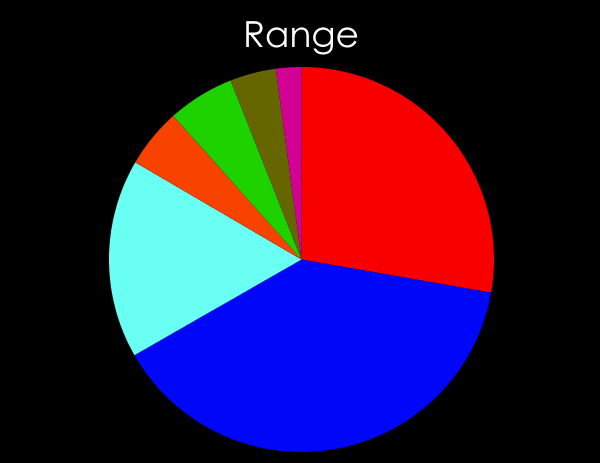| Candidate | Plur | RV | AV |
|---|---|---|---|
| Bush(Rep) | 50.7 | 40 | 39 |
| Kerry(Dem) | 48.3 | 56 | 61 |
| Nader | 0.38 | 24 | 21 |
| Badnarik | 0.32 | 7.2 | 0.64 |
| Cobb | 0.10 | 8.1 | 2.1 |
| Peroutka | 0.12 | 5.6 | 1.0 |
| Calero | 0.003 | 3.1 | 0 |
| Total3rd | 0.92 | 48 | 25 |

|

|

|
Warren D. Smith. Updated to higher accuracy Sept. 2007.
Here is the world's only actual data (as of 2005) about range & approval voting vis-a-vis US third parties – given in my paper (#82 here) coauthored with Doug Greene & Jacqueline Quintal.
This is based on a pseudo-election we conducted with real US voters (122 range voters and 656 approval voters) simultaneously with the 2004 presidential election (as an exit poll).
|
|
As you can see, under range voting (RV) the third party candidates all would have done a lot better relative to Bush and Kerry than under either approval voting (AV) or the current plurality (plur) system. This illustrates the huge anti-third-party distortion that plurality voting usually causes.
[Warning: do not conclude from this that under RV or AV, Kerry would have beaten Bush in 2004. That is mostly an artifact of the fact these polls were of voters in New York State and Philadelphia PA suburbs, areas in which Kerry did beat Bush – and did so comparably to our AV and RV poll results. Bush won nationwide, as you can see from the "Plur" column. It is legitimate to conclude RV will cause third parties to get a lot more support, since in NY state and Philadelphia the third party plur voters were very rare. The "Total3rd" row is just the sum of Nader, Badnarik, Cobb, Peroutka, and Calero results – which is admittedly somewhat meaningless – but anyhow as you can see it actually would have exceeded Bush's total under range voting. Please see the full paper if you want, e.g, statistical error bars, which are omitted here for simplicity.]
[Warning: the data on Socialist Worker's Party candidate Calero is included with some trepidation because there was not much data on him. But as you can see what there was of it also suggested that he would have gotten lots more range votes than under either AV or plurality.]
(Worried about the nonlinearity bogeyman?)
Check out the French Approval-Voting and French Range-Voting studies. And our range-voting polls collection for key historical elections.
Also, you may be interested in the following. In the 1992 US Presidential Election, according to an analysis of National Election Study data by Steven J. Brams and Samuel Merrill III [Politics and Political Science 27,1 (March 1994) 39-44], the vote totals again would have been tremendously altered with approval voting (although the finish order would not have changed) again illustrating the tremendous distortionary penalty faced by third-party candidates under the plurality system.
| Candidate | Plur | AV |
|---|---|---|
| Clinton(Dem) | 43.0 | 55 |
| Bush(Rep) | 37.4 | 49 |
| Perot | 18.9 | 42 |
And in the 1980 US Presidential Election, according to the analysis based on many polls in chapter 9 of Brams & Fishburn's book, Anderson probably actually would have come in second behind Reagan but ahead of Carter, under approval voting, whereas under plurality voting he was far in third place with under 7% of the votes. Again this illustrates the tremendous distortionary penalty faced by third-party candidates under the plurality system.